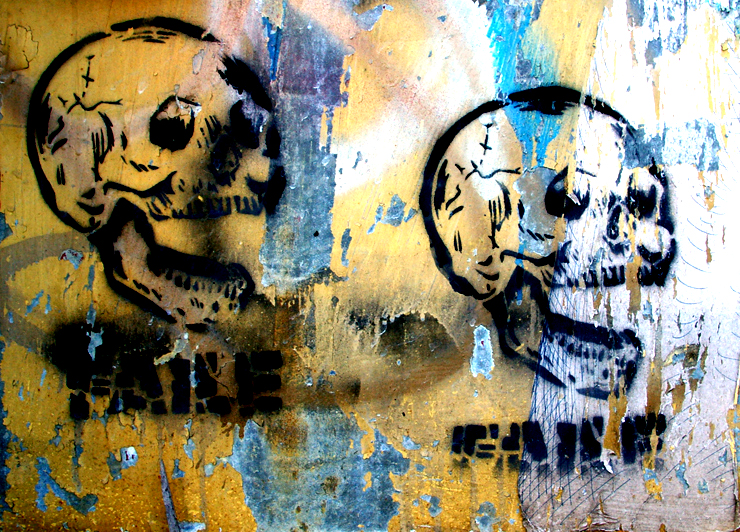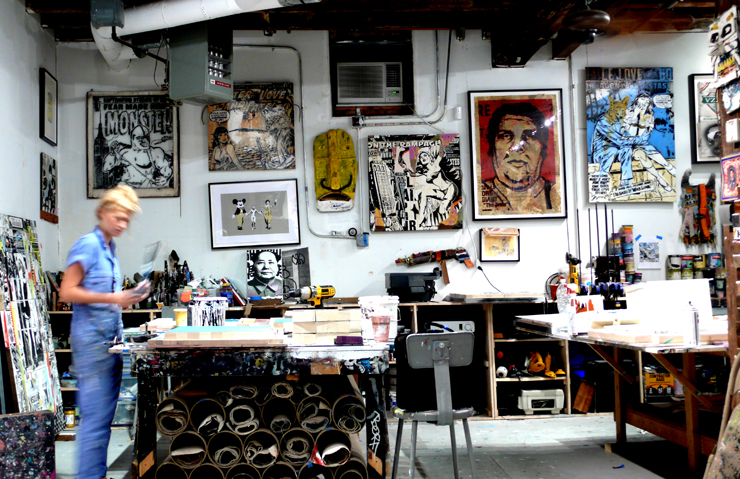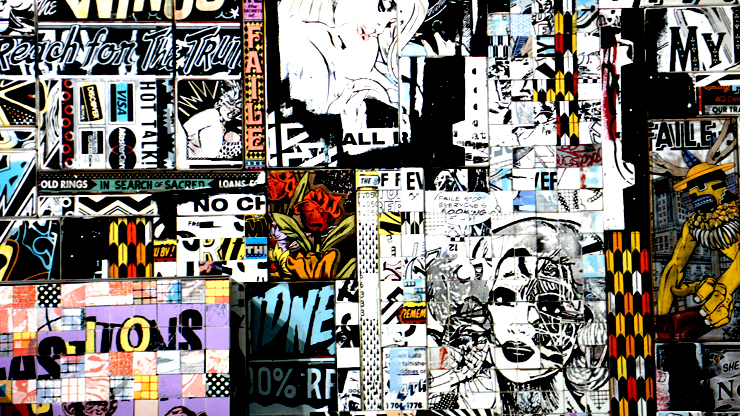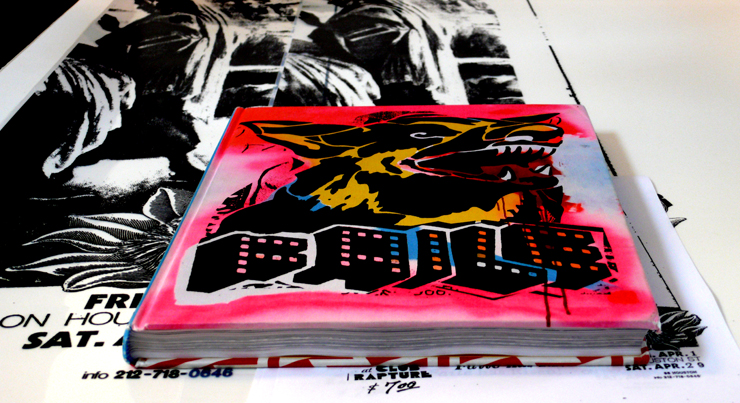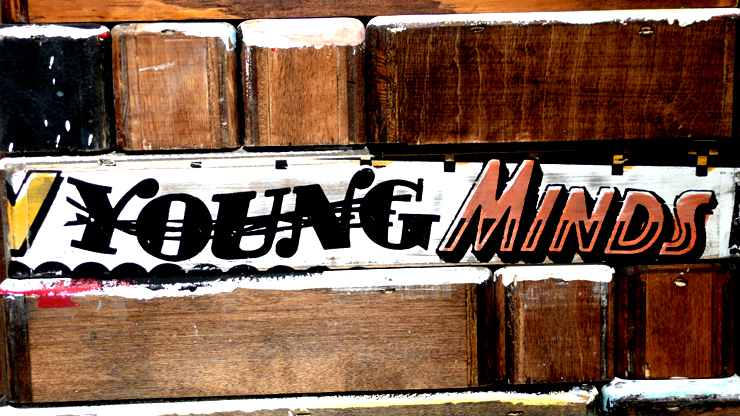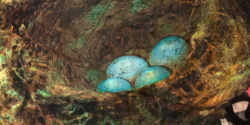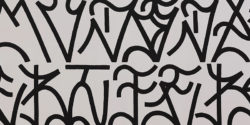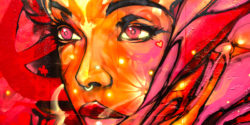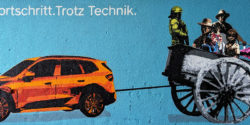A visit with Street Art collective Faile in their Brooklyn studio finds the industrious duo at the center of a small cluster of assistants working on many projects simultaneously.
The air of collaboration is evident in this maze of activity – as well as an appreciation for process. The multi-level ex-industrial building has been reconfigured internally over the last decade to contain and accommodate the adventurous appetites of the childhood buddies who took their Street Art from Brooklyn to the Tate, with many stops along the way.
This doesn’t happen for everybody, so in this first visit of two before their upcoming debut solo show at Perry Rubenstein Gallery on November 4, we looked for clues about the creative and working DNA of Faile. In the ten quick long rotten beautiful years of this century they’ve plowed through many experiments methodically from simple one color small stencils on light posts to now museum quality raft-sized wooden block collages that take months to screenprint, saw, sand, and assemble.
One of Faile’s first street pieces from the late 90’s in Williamsburg, Brooklyn. (Photo © Jaime Rojo)
In a pretty remarkable run through the neighborhood and the globe the two Patricks have used aerosoled stencils, screen prints, wheat pastes, roller tags, animated video games, carved wood, vinyl sculptures, spinning prayer poles, even alabaster and tile reliefs in their ever growing collection of work. Cumulatively, the forays have given depth and resilience to their nearly iconic pop imagery.
Since returning from their Lisbon temple installation mid summer, where their piece (two years in the making) became a focal point for that city’s first biennial, the Faile dudes are now making a multitude of these “wood paintings” here in their Brooklyn studio. Among the many silkscreens stacked against walls, rolled canvasses in tubes, and pieces by Banksy and Shepard Fairey adorning the walls, there are open wooden boxes, maybe 20 or 30, full of small wooden printed blocks laying open on tables and shelves.
Brooklyn Street Art: When the blocks get that small they are almost just a texture.
Patrick McNeil: Exactly, or just color palette. It’s so modular you don’t get stuck with anything, you get to explore a lot and if it doesn’t work you just put it back the way that it was or pull it apart.
Brooklyn Street Art: That’s right, you can reverse yourself pretty easily
Patrick McNeil: Yeah you just kind of build a piece and then realize it works better in something bigger – so they are very loose in a sense. It seems very precision-y and thought out but it’s much more looser than it looks.
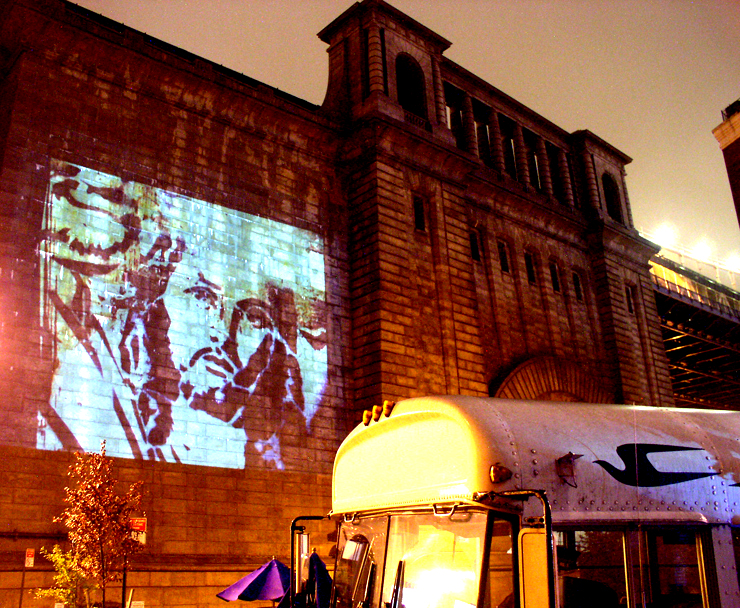
Faile’s Jesus appears on the side of the Manhattan Bridge during Brooklyn Street Art’s “Projekt Projektor” show in Brooklyn during the DUMBO Arts Festival in 2008 (Photo © Jaime Rojo)
The selective sampling of images that create the Lingua Faile has steadily grown into a library of totems, symbols, pulp art snippets, typefaces and signifiers set free from their context and recombined with a lucid dexterity, a splash of irony, and an inner voice that says, ‘go for it’. It’s an old-skool visual sampling that doesn’t need autotune for anything, just a hyped sense for combining clips and dropping it on the beat. Talking to them, one sees that it’s a loose intuitive sense that is guiding the process.
Patrick McNeil: And I like what is happening in this one, it’s still coming along. That one, the bottom needs to be worked out. It’s really top heavy. And we’ll kind of pull some colors down. That one is just kind of getting started. This one’s kind of in the middle right now; Just slowly working on blacks and switching things up.
Brooklyn Street Art: So you’ve used a lot of powdered pastels…
Patrick McNeil: Yeah…
Brooklyn Street Art: let’s see, blasting fluorescents…
Patrick McNeil: Well a little bit, yeah. There are not too many fluorescents, well, that pink is probably the only fluorescent. Well, there’s yellow on that one. But none of these have any fluorescent.
Brooklyn Street Art: I’m thinking of the DeLuxx Flux thing you did with Bast.
Patrick McNeil: Yeah Perry made the rule, “no fluorescents”.
Brooklyn Street Art: Oh okay. Well it’s good to have that guidance.
Patrick McNeil: Yeah, we might sneak one in there.
Patrick McNeil: Then we were looking more at abstractions, breaking color groups up, pushing it really far.
Brooklyn Street Art: Yes that’s an unusual combination of the violet and the grey. It looks fresh.
Patrick McNeil: Yeah, it’s kinda switchin’ it up. We kind of like tweak things and leave them up for a while and then switch it out. It’s kind of interesting.
Even though the new book, their first, is coming out to mark the first 10 years that took them from Brooklyn streets to group shows, street art exhibitions, galleries, and museums around the globe, the creative partners are focusing right now on the work at hand. A decade of work, play, and planning together has created a shorthand of cues and patterns and symbols that makes their work move quickly without much strife or discussion. In the studio it’s equal parts industry and creativity – where real world dedication to process and structure adds a loose tension to the spirit of play.
Brooklyn Street Art: Are you both the leader? Or do you take turns being the leader? Is there one who just says “THIS is where we have to go!”
Patrick McNeil: It goes back and forth really.
Patrick Miller: It’s pretty rare when it is “This is the way it has to be and there is no room for discussion”
Brooklyn Street Art: So you don’t come to loggerheads?
Patrick McNeil: No, we’ve known each other since we were 14 so we’ve got a pretty good friendship.
The new block collages, or “wood paintings” started about a year ago and the artists introduced them at Cour Carrée du Louvre for the FIAC in Paris. With a loyal fanbase that hangs on their every print release and microsite revelation, the new pieces were an instant hit and complete success. The scale of pieces at that time seemed manageable and something you might carry as part of your luggage; however some of these new wood paintings for the Rubenstein show might well be snagged by Swoon for walls in one of her Konbit shelters.
Brooklyn Street Art: How do you achieve a sense of balance? You have the professional, personal,… family is growing.. How do you guys achieve a sense of balance regularly?
Patrick Miller: For one, we treat this like a pretty regular thing in the sense of working Monday through Friday, pretty much 9:30 to 6:00.
Brooklyn Street Art: So you have a schedule and a structure.
Patrick Miller: Yeah, so we have structure in that sense. It’s a business after all on some level, and it has to be thought of in that way too. I mean it’s tough some times when we have big shows going on and we’re traveling and trying to not be away from the kids for too long. But you know, I guess I never stopped to think about it. It was nice last year because Patrick and his wife had their second child and we had our first within a few weeks of each other, and so that worked out really well, in the sense of timing-wise. We were able to slow down a bit.
Brooklyn Street Art: You know I was just thinking about the blocks and interactivity. I wonder if you could make a piece where some of the blocks were free and the person who buys it could play with the blocks.
Patrick Miller: Hey, you’re really onto something!
Patrick McNeil: Let’s go upstairs.
Brooklyn Street Art: You’ve already thought of this!
We shuffle eagerly behind our hosts like hypnotized penguins out to the darkened hallway and up some stairs to a high security print room that is pristine and plum full of stuff that might make you cry – things they’ve collected, been gifted, or just like to entertain visitors with. They could drop names but the brothers Faile are more interested to show one of their newest inventions, a wooden tray of blocks that form a puzzle – well, six actually. The lo-tech games perfectly marry our current digital longing for interactivity and the latent one to become a Luddite.
Patrick Miller: (The puzzle boxes) kind of came up in Paris, so we just developed these pieces on the side totally on their own. Then we started thinking there are some situations and combinations that we really liked. Each one is printed on all six sides and you can manipulate it and play with it.
Brooklyn Street Art: Hours of endless pleasure! How do you prevent them from getting damaged?
Patrick McNeil: That’s just part of it.
Patrick Miller: I don’t think they’re going to get too damaged. They are already sanded and their meant to be touched. We’re actually making a site, because it’s really hard to show them.
Brooklyn Street Art: Have you thought of customization on the site so people can select options and order it?
Patrick: Yes we’ve thought of that but effectively you’d have tons of combinations.
Brooklyn Street Art: Have you thought of doing an app for these so people can play with them?
Patrick: Yeah and that is something that may come out of it. The people that we work with… That would be a fun thing, as a little game. And it’s actually pretty simple because the navigation is just like ‘click’ and it turns it. It should be a fun little site. It’s been fun to do these little micro sites.
Brooklyn Street Art: Right, with a phone’s motion sensor you could roll the blocks around. Wow, you guys are on top of it.
This visit draws to an end with a promise to rejoin shortly before the show to see the progression. But before we go, the new book is placed with slight aplomb on the counter. The one and only copy they’ve received from the printer, we stare at it like cats at an aquarium. The splashy pink raging dog cover says the thing about Faile you might not notice on a casual tour; these guys are ferocious in their desire to succeed and have built a body of work to prove it.
Tentatively peeling back the pages of the book, we see that the first image is the simple stencil of a figure carrying a canvas with his back to you and the words “A Life”, their first name, across the top. Anyone stumbling home drunk through industrial Williamsburg in the late 90’s would remember what curiosity was sparked with this humblest of images scattered everywhere. Later they anagrammed it to form their current name.
Brooklyn Street Art: So “A Life” got converted to Faile, which is just the opposite of what you’ve done!
Patrick Miller: Yeah it was always kind of about growing from it and making the most of all your failures.
Brooklyn Street Art: Did you both design the book?
Patrick Miller: We worked on it with a friend of ours. It was such an undertaking. But it’s good. It’s definitely a pretty personal book in the way that it’s written, very friendly, an enjoyable read. It’s nice just to have the works on print.
Patrick McNeil: It’s nice to see the earlier work, and it’s nice to see how the process goes because it’s chronological as well.
Brooklyn Street Art: Who is going to have seen all of this stuff besides you two? Nobody.
Patrick Miller: It’s a nice way to put it together for yourself too, after 10 years of working on Faile it’s nice to have this.
 BROOKLYN STREET ART LOVES YOU MORE EVERY DAY
BROOKLYN STREET ART LOVES YOU MORE EVERY DAY